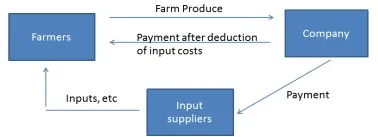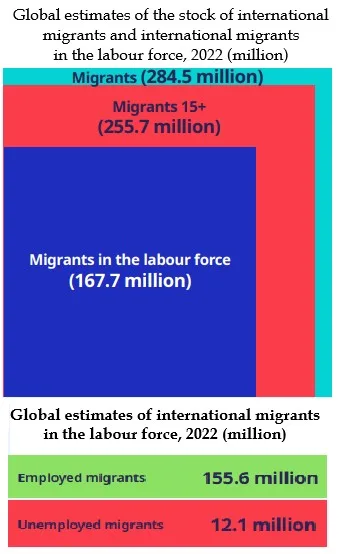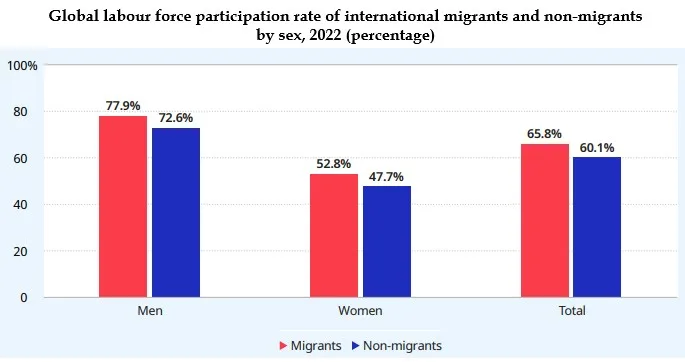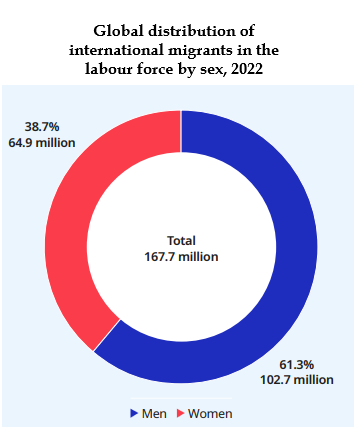UPSC DAILY CURRENT AFFAIRS (19TH JANUARY, 2025)
Contract Farming
Syllabus:GS3/ Agriculture
Context
- The shift from importing to exporting frozen French fries in India, highlights the importance of contract farming for both the agricultural industry and farmers.
What is Contract Farming?
- Contract farming is agricultural production carried out according to an agreement between farmers and a buyer, which places conditions on the production and marketing of the commodity.
- Farmers: They agree to produce specified agricultural commodities based on the buyer’s requirements, adhering to quality, quantity, and timing standards.
- Buyers: They are usually agribusiness firms, processors, exporters, or retailers who provide inputs like seeds, fertilizers, and technical know-how, along with a guaranteed price for the produce.
Types of contract farming arrangement
- Direct Input Provision by the Company: The company supplies all necessary inputs to the farmers, and the cost of these inputs and services is deducted from the price the farmer receives for the produce after harvest and delivery.

- Partnership with Local Input Dealers: These arrangements represent a spectrum of company involvement, balancing between direct control and reliance on third-party service providers. The choice of arrangement depends on:
- Availability of local service providers.
- The company’s resources and capabilities.
- The complexity of the crop production process.

Advantages of Contract Farming
- Assured Income: Farmers are assured of a market for their produce at a predetermined price, reducing income uncertainties.
- Access to Quality Inputs: Buyers provide high-quality seeds, fertilizers, and advanced technology, enhancing productivity and quality.
- Reduction in Post-Harvest Losses: With proper guidance and market access, post-harvest losses can be minimized.
- Facilitates Credit Access: Contracts often enable farmers to secure loans from financial institutions due to the guaranteed income stream.
Concerns associated with Contract Farming
- Power Imbalance: Farmers, particularly smallholders, may have limited bargaining power, making them vulnerable to exploitation.
- Side-Selling: Sometimes farmers sell the contracted produce to other buyers if offered a better price, breaching the agreement.
- Quality Disputes: Disagreements over quality standards lead to conflicts and delays in payments.
- Exclusion of Marginal Farmers: Buyers prefer to work with larger farmers for economies of scale, sidelining small and marginal farmers.
- Environmental Concerns: Emphasis on specific crops lead to monocropping, soil depletion, and overuse of inputs.
Government Initiatives and Legal Framework
- Model Agricultural Produce and Livestock Contract Farming and Services Act, 2018 provides a framework for fair agreements, dispute resolution, and safeguards for farmers.
- Farmer Producer Organizations (FPOs) encourage collective bargaining power for farmers in contract farming.
- e-NAM Integration: It facilitates transparency in contract enforcement and pricing.
- National Policy on Agriculture: Promotes contract farming as a means to enhance productivity and rural income.
Way Ahead
- To ensure the sustainable growth of contract farming, it is essential to focus on inclusive practices, technological advancements, and robust evaluation mechanisms.
- Contracts should be tailored to accommodate small and marginal farmers, simplifying terms and providing affordable input support.
- This inclusivity will empower underrepresented farming communities, ensuring equitable growth across the agricultural sector.
ILO Report On International Migrants
Syllabus: GS2/IR; GS3/Economy
Context
- The International Labour Organization (ILO) recently published the fourth edition of its Global Estimates on International Migrant Workers, highlighting the significant contributions and challenges faced by international migrants in the global labor market.

Key Findings of Global Estimates on International Migrant Workers (ILO)
- Contributions to Global Economy: In 2022, International migrants made up 4.7% (167.7 million) of the global labor force, which includes both employed and unemployed individuals.
- It marks an increase of over 30 million compared to 2013.
- Regional Distribution:
- High-income Countries absorbed the largest number of International migrants, accounting for 68.4% (114 million people), primarily in key sectors such as services, especially in the provision of care.
- Upper-middle-income countries accounted for 17.4% (29.2 million) of International migrants.
- The share of International migrants in the labor force in Northern, Southern, and Western Europe was 23.3%, while in Northern America, it was 22.6%.
- Employment Sectors:
- Services Sector: 68.4% (higher than non-migrants);
- Women (80.7%) and Male (60.8%);
- Care Economy: Migrant women (28.8%) and Migrant men (12.4%);
- Industry Sector: 24.3%
- Agriculture: 7.4%
- Non-migrants share in agriculture: 24.3%.
- Services Sector: 68.4% (higher than non-migrants);
- Age Distribution:
- Prime-age adult (between 25 and 54 years): 74.9% (125.6 million);
- Young (between 15-24 years): 9.3% (15.5 million);
- Between 55-64 years: 12.5%;
- Above 65 years: 3.4%

- Gender:

- Men constituted 4.7% of the total male employment.
- Women accounted for 4.4% of the total female employment.
- However, the number of women International migrants has steadily risen since 2015.
Significance of International Migrants
- Addressing labor market shortages in host nations and contributing remittances to their home countries.
- In 2024, India received an estimated $129.1 billion worth of remittances (14.3% of the world), the highest ever for a country in any year. These funds support families, boost local economies, and contribute to national development.
Challenges and Growth Rate Highlighted in Report
- The report noted that the rate of growth of International migrants dipped annually to less than 1% between 2019 and 2022, influenced by factors such as the pandemic.
- Gender Disparities: Migrant women faced higher unemployment rates (8.7%) compared to migrant men (6.2%), and their employment-to-population ratio was significantly lower at 48.1%, versus 72.8% for men.
- Factors contributing to these disparities include language barriers, unrecognized qualifications, discrimination, limited childcare options, and gender-based expectations.
- Higher Unemployment Rates: Migrants faced a higher unemployment rate (7.2%) than non-migrants (5.2%), with women more affected.
Policy Recommendations
- To maximize the benefits of labor migration, the ILO emphasizes the need for comprehensive policies that enhance labor mobility, protect workers’ rights, and promote inclusive growth.
- These policies should address the specific needs of migrant workers, ensuring their safety, dignity, and economic well-being.
| About International Labour Organization (ILO) – It is an United Nations Agency established in 1919 as part of the Treaty of Versailles that ended World War I, and it became the first specialized agency of the UN in 1946. 1. It is the only tripartite U.N. agency that brings together governments, employers and workers. – It has 187 Member states. – It sets labour standards, develops policies and devises programmes promoting decent work for all women and men. – It is headquartered in Geneva, Switzerland. Major Reports – World Employment and Social Outlook (WESO); – Global Wage Report;World Social Protection Report; – World Employment and Social Outlook for Youth; – World of Work Report |
Revised Open Market Sale Scheme (Domestic) Policy for 2024-25
Syllabus :GS3/Economy
In News
- Recently, the Government announced a significant revision in the Open Market Sale Scheme (Domestic) [OMSS(D)] Policy for the year 2024-25.
Open Market Sale Scheme (Domestic)
- The scheme involves the periodic sale of excess food grains (wheat and rice) from the central pool by the Food Corporation of India (FCI).
- Sales are made in the open market to dealers, bulk consumers, and retail chains at predetermined prices fixed by the Ministry of Consumer Affairs, Food & Public Distribution through e-auction .
- In 2022-23, Karnataka, Tamil Nadu, Jharkhand, Jammu & Kashmir, and Assam bought the highest share of rice under OMSS.
- States’ Role in OMSS: States can acquire food grains under OMSS without participating in auctions to meet additional needs beyond their NFSA allotment.
- The acquired grains are distributed among beneficiaries of the National Food Security Act (NFSA).
- Procurement Process: Wheat and paddy are procured by FCI and state corporations during the Rabi and Kharif seasons based on government procurement estimates.
- Procurement is done in line with the Minimum Support Price (MSP).
Latest Updation
- Fixation of Reserve Price for Rice: The reserve price of rice has been fixed at ₹2,250 per quintal (Pan-India) for sale to State Governments, State Government Corporations, and Community Kitchens, without the requirement of participating in e-auctions.
- Ethanol Production Support: The reserve price of rice for sale to ethanol distilleries for the production of ethanol has also been fixed at ₹2,250 per quintal (Pan-India).
Objectives and Need
- OMSS is activated during the lean season (period between harvests) to manage and enhance the domestic supply of wheat and rice.
- The aim is to reduce food grain prices in the open market and mitigate food grain inflation.
- The recent decisions reflect the Government of India’s commitment to supporting states in fulfilling their obligations under state schemes, promoting food security, and bolstering ethanol production as part of the national energy strategy.
| Do you know? – The Food Corporation of India (FCI) is a statutory body set up under the Food Corporation’s Act of 1964. – It operates under the Ministry of Consumer Affairs, Food & Public Distribution. – Objectives: It aims to safeguard farmers’ interests through effective price support operations. 1. Ensures the distribution of foodgrains across the country. 2. Maintains adequate operational and buffer stocks of foodgrains to secure National Food Security. |
Ledger Technology to Tackle Spam
Syllabus: GS3/Cybersecurity
Context
- The Telecom Regulatory Authority of India (TRAI) will be using distributed ledger technology (DLT) to register spam preferences from customers.
About
- Spam rules will be tightened to make commercial messages traceable, the TRAI has indicated.
- Spam messages and calls refer to unwanted, unsolicited communications typically sent for advertising, scams, or other malicious purposes.
Concerns of the Spam
- Privacy Invasion: Spam calls and messages often lead to a breach of personal privacy, as they can involve unwanted sharing of personal information.
- Scams and Fraud: Many spam messages and calls are used to deceive individuals into sharing sensitive data (like bank details), leading to financial loss and identity theft.
- Overload and Disruption: The sheer volume of spam messages and calls can overwhelm users, disrupt daily life, and cause annoyance.
- Regulatory Challenges: While there are laws like the TRAI guidelines to curb spam, enforcement is often weak, and new tactics from spammers outpace regulatory efforts.
- Lack of Awareness: Many people, especially in rural areas, are unaware of how to block or report spam, making them more vulnerable to scams.
Regulations of Spam in India:
- The TRAI regulates the telecom industry, and its main role is in regulating Unsolicited Commercial Communications (UCC), the official name for spam.
- DND Registry: Starting in 2007, the regulator implemented a do-not-disturb (DND) registry, if a telecom customer signs up to the DND registry, they are not supposed to get any spam calls or SMS messages.
- TCCCPR 2018: Under the Telecom Commercial Communication Customer Preference Regulation (TCCCPR), 2018, telemarketers who called or sent messages to DND-registered customers would receive warnings.
- In case and if enough warnings accumulated, they would be blacklisted from sending messages to telecom operators.
- In 2024, TRAI mandated that DND reporting be made available on every telecom provider’s app.
Distributed ledger technology (DLT)
- TRAI has mandated the telcos to use a blockchain ledger, also known as a distributed ledger.
- Blockchain as a technology allows for so-called immutability, which means that every stakeholder involved in a transaction has a reliable, un-tamperable version of the same data.
- Features:
- It will store a constantly-updated list of approved senders of SMS messages.
- Telcos would also be required to approve specific formats of messages.
- This has been one of the most stringent rules that have been issued to fight SMS spam anywhere in the world.
- Significance:
- This will make sure that telcos would have a complete record of who issued a message before it is sent to an SMS gateway.
- This was aimed at plugging a crucial flaw in the system that would allow anyone to register on the blockchain solutions.
Other Measures to Flag Spams:
- Sanchar Saathi Portal: The Department of Telecommunications (DoT) has launched the Sanchar Saathi portal, which has a reporting site called Chakshu.
- DoT has partnered with law enforcement, banks, and other stakeholders in order to accept reports of “suspected fraudulent” calls and messages.
- It has moved to cancel lakhs of numbers that are associated with unauthorised telemarketers and scammers.
- It also set up the Telecom Security Operation Centre at its New Delhi headquarters to monitor suspicious internet traffic in real time.
- Firms like Airtel have taken steps to declare suspicious calls using Artificial Intelligence as “Suspected Spam,” a move that is being replicated by other telcos as well.
- The telco has also started labelling international calls on smartphones.
Outward Foreign Direct Investment
Syllabus: GS3/Economy
Context
- As per the RBI, Outward foreign direct investment (OFDI) by domestic firms has seen a jump of nearly 17% to $37.68 billion in 2024.
About
- In 2023, total overseas direct investment stood at $32.29 billion.
- In the last calendar year, overseas FDI by local companies in the form of equity stood at $12.69 billion, a rise of 40% over the 2023.
- This is a positive sign that Indian companies are also going global.
Overseas Direct Investment
- Overseas Direct Investment (ODI) refers to an investment made by a company or individual in assets or businesses located in another country.
- It involves directly owning and controlling a foreign business or setting up operations such as subsidiaries, joint ventures, or branches in foreign markets.
- Key points about ODI:
- Control and Influence: A significant level of control or influence over the foreign business (usually at least 10% ownership).
- Purpose: To expand their operations, access new markets, benefit from resources, or diversify risks.
- Investment Forms: It can include investments in foreign companies, real estate, infrastructure projects, or other assets.
- Sectors for Investment by India: Hotels, construction, manufacturing, agriculture, mining and services.
- Countries for Investment: Singapore, US, UK, UAE, Saudi Arabia, Oman and Malaysia, among others.
Significance
- Transfer of technology and skill, sharing of results of research and development (R&D),
- access to wider global market,
- promotion of brand image,
- generation of employment and utilisation of raw materials available in India and in the host country,
- drivers of foreign trade and also a source of foreign exchange earnings.
Conclusion
- Joint ventures (JVs) and wholly owned subsidiaries (WOS) have become vital avenues for Indian businesses aiming to boost their global presence.
- The fact that Indian companies are investing in their own subsidiaries indicates that they are expanding outside.
- The Indian companies’ continued international reach are not only helping them expand globally but are also fostering deeper economic ties between India and other nations.
FACTS IN NEWS
Kalaripayattu
Syllabus: GS 1/Culture
In News
- Kalaripayattu has been relegated to the demonstration section for the 38th National Games in Uttarakhand, scheduled to begin on January 28.
Kalaripayattu
- It is an ancient martial art originating from Kerala, India, but practiced worldwide.
- The term “Kalari” in Malayalam refers to a traditional gymnasium where this martial art, known as Payattu, is taught.
- Mythological Belief: Some believe Kalaripayattu was introduced by Lord Parasurama, the sixth incarnation of Lord Vishnu, after reclaiming Kerala from the sea.
- However, historians date its origin between 200 BCE and 600 CE, with its peak popularity between the 14th and 16th centuries.

- Stages of Kalaripayattu:
- Maippayattu: Body conditioning phase, preparing the body for combat.
- Kolthari: Training with wooden weapons (short and long sticks) for attack and self-defense.
- Angathari: Training with sharp metal weapons after overcoming fear of wooden weapons.
- Verumkai: Bare-hand fighting, with a focus on body anatomy and target points for strikes.
- Significance : It has been widely admired for its complex techniques, graceful movements, and the impressive flexibility of its practitioners, as recorded by chroniclers and poets over time
| National Games 2025 – Uttarakhand will host the National Games 2025 from January 28 to February 14, 2025. – Over 10,000 athletes, officials, and coaches will participate in 38 sports. – The mascot for the Games is “Mauli”, inspired by the Monal (Uttarakhand’s state bird). – The Games tagline is: “Sankalp Se Shikhar Tak” (From Resolve to Zenith). |
BRICS
Syllabus: GS2/ International Organisations
In News
- Nigeria becomes the ninth partner country of BRICS, joining Belarus, Bolivia, Cuba, Kazakhstan, Malaysia, Thailand, Uganda, and Uzbekistan.
About BRICS
- Definition: BRICS is an intergovernmental informal grouping of emerging economies aimed at fostering cooperation and enhancing their global influence.
- Members: Brazil, Russia, India, China (these are founding members); South Africa joined in 2010; Iran, UAE, Egypt, Ethiopia, Saudi Arabia joined in 2024, Indonesia joined in 2025.
- Argentina was initially expected to join in 2024 but later opted out.
- Background: The first BRIC Summit was held in Russia in 2009.
- Importance: The BRICS grouping represents approximately 40% of the global population, making it one of the largest demographic blocs in the world.
- It also accounts for an estimated 37.3% of global GDP, highlighting its significant contribution to the global economy.
Securities Transaction Tax
Syllabus: GS3/ Economy
Context
- The Securities Transaction Tax (STT) collection has surged by over 75%, reaching Rs 44,538 crore as of January 2025, compared to Rs 25,415 crore during the same period in 2024.
What is Securities Transaction Tax (STT)?
- STT is a type of tax that is charged on the purchase and sale of securities like stocks, mutual funds, and derivatives on recognized stock exchanges in India.
- It is a direct tax, meaning that it is levied directly on the transaction value of securities.
- The STT was introduced in India in 2004 to replace the earlier system of imposing a tax on securities transactions called the “stamp duty.”
- The 2024 budget has increased the securities transaction tax (STT) on Futures & Options (F&O) of securities to 0.02 percent and 0.1 percent respectively.
Nord Stream Pipeline
Syllabus: GS3/ Environment
In News
- The Nord Stream subsea pipeline leaks released an estimated 465 ± 20 thousand metric tons of methane into the atmosphere.
About Nord Stream Pipeline
- About: The Nord Stream is a major subsea gas pipeline system spanning 1,200 km under the Baltic Sea, designed to transport natural gas from Russia to Europe.
- Key Features: Gas originates from the Bovanenkovo oil and gas condensate deposit in Western Siberia, Russia.
- Components: Nord Stream 1 completed in 2011 ( Route from Vyborg in Leningrad Oblast, Russia, to Lubmin, Germany.)
- Nord Stream 2 completed in 2021 ( Route from Ust-Luga in Leningrad Oblast, Russia, to Lubmin, Germany.)
Significance
- The Nord Stream pipelines are among the largest subsea gas pipelines in the world.
- They are central to Europe’s energy strategy but have also been at the center of geopolitical and environmental debates, particularly amid strained relations between Russia and Western nations.
Dark Oxygen
Syllabus: GS3/ S&T
In News
- The recent discovery of “dark oxygen” production in the Clarion-Clipperton Zone challenges conventional understanding of oxygen generation, which has long been tied to photosynthesis requiring sunlight.
Key Findings
- Metallic nodules found 4,000 meters beneath the Pacific Ocean’s surface generate oxygen through electrolysis.
- This process does not depend on sunlight, marking a paradigm shift in the understanding of oxygen generation.
Potential Applications
- This phenomenon could provide insights into life in extreme environments on Earth and other planets.
- Understanding “dark oxygen” production could assist in the search for extraterrestrial life by expanding the criteria for habitability.
India’s First Indigenous Surgical Tele-robotic System
Syllabus :GS3/Science and Technology
In News
- India’s first indigenous surgical tele-robotic system, SSI Mantra, was used to perform two complex heart surgeries remotely, with the surgeon in Gurugram and the patient in Jaipur.

About SSI Mantra
- SSI Mantra is a robotic system that performs complex surgical procedures in Genito-Uro-Oncology cases.
- It is developed by SSI Ltd and it is the only robotic system worldwide to receive regulatory approval for telesurgery and tele-proctoring.
- Its recent approval by the Central Drugs Standard Control Organization (CDSCO) paves the way for remote surgeries and medical education, allowing healthcare professionals to collaborate across distances.
- Benefits: Reduced operation time, better precision, minimal trauma, lower blood loss, faster recovery, and reduced infection risk.
- The technology aims to bridge geographical gaps in surgical care, making tele-surgery accessible globally.
- Challenges to Wider Adoption: High costs of robotic surgeries, which are currently more available in metro and tier-1 cities.
- Other Challenges included latency time, requiring good connectivity, and addressing potential technical problems.
